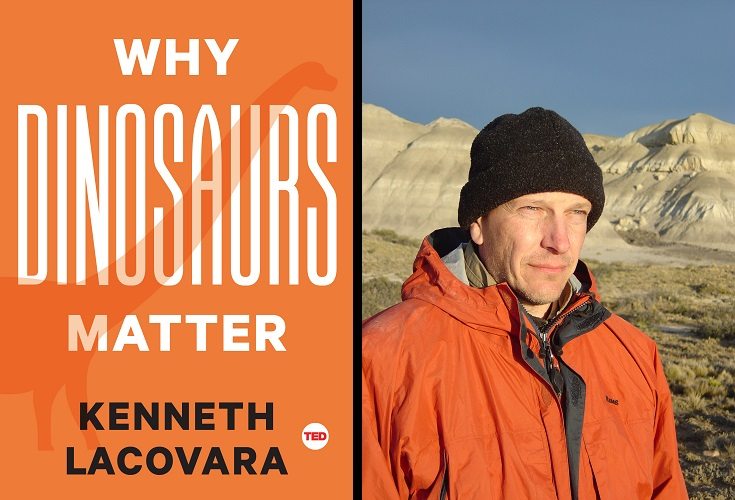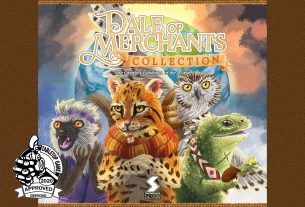Listen, when a book comes with endorsements by Dr. Jane Goodall and Adam Savage, you’re pretty much obligated to check it out. And when it’s about dinosaurs? Yeah, there’s no turning away from this one.
Kenneth Lacovara’s Why Dinosaurs Matter is an expansion of his TED talk, Hunting for Dinosaurs Showed Me Our Place in the Universe. Lacovara is a professor of paleontology (and a working paleontologist) who has unearthed some of the largest dinosaurs ever to roam Earth. Included in his resume is the super-massive Dreadnoughtus schrani, which at 65 tons weighs more than seven T. rex!
In the book, Lacovara tackles the misconception that dinosaurs were evolutionary failures. I mean, after all, how many times do we use the word dinosaur to refer to something that’s no longer relevant or has failed in some way? What most people neglect to keep in mind, though, is that modern-day birds are dinosaurs. They are not “like” dinosaurs. They do not share a common ancestor with dinosaurs. They are dinosaurs. Dinosaurs are still among us; they just no longer have primacy over the planet.
“Inculcated for decades with a host of misconceptions, it’s easy to see how the public came to view these noble and spectacularly successful creatures as failures: as the evolutionary equivalent of the VHS tape, the DeLoreans of the Mesozoic Era, the Woolwoorths of the fossil record.”
The book is filled with mind-blowing gems on nearly every page: “If every bird on every continent were to die today, mammals would not surpass the temporal success of the dinosaurs until the year 21,002,017.”
Why Dinosaurs Matter is a relatively slim book that can easily be devoured in a single sitting. But the ideas it contains will percolate for weeks. Lacovara devotes the initial chapter to answering the titular question and then spends the rest of the book giving a history of paleontology and how humanity came to recognize and understand “deep time,” which granted us the ability to see past our own noses (figuratively speaking) and comprehend an Earth ruled by monsters for which we have no basis of comparison: “With our discovery of deep time, evolution, and common descent, we saw that far from being the reason why our planet exists, we are but one among multitudes, each one being enormously lucky, each one contingent on so much else, and each one here by for a fleeting moment in the vast tapestry of deep time.”
The book is a fascinating insight into our collective history with prehistory and how humanity has managed to use our scant allotment of time to understand what came before. It’s also a vital call to arms for humanity to wake up and recognize what we’re doing to ourselves and our planet. The dinosaurs didn’t see the asteroid coming; they couldn’t have done anything differently. We, however, can see the impending climate crisis descending. And we can do something about…if we choose to.
“Why study the ancient past? For me, the answer is: because it gives us perspective and humility. The present is nothing but a fleeting instant. Gone before you can think of it. It’s only the past that gives context to our world. Ans it’s the past that gives us foresight. Dinosaurs matter because the future matters.”
GeekDad: What’s the most frustrating misconception about dinosaurs you hear and have to keep correcting?
Kenneth Lacovara: There are so many: T. rex was the largest dinosaur. Oil comes from dinosaurs. Mosasaurus were dinosaurs. Pterosaurs were dinosaurs. Dinosaurs were just too dumb to survive. I could go on and on. It’s amazing, considering their vast popularity, that dinosaurs are so widely misunderstood. Perhaps the one misconception that gets me most, the one that I have to deal with almost every day, is the confusion between paleontology and archaeology. As I write in the book, paleontology and archaeology are widely separated disciplines, with almost no overlap. Archaeologists study human artifacts, things that are hundreds or thousands of years old. Paleontologists study the ancient, fossilized remains of plants, animals, and single-cell organisms – things that are millions of years old and occurred long before Homo sapiens.
GeekDad: Paleontology is one of those career choices that nearly every kid (mine included) wants to be at some point. But relatively few go through and actually become a paleontologist. Why do you think that is?
KL: When I tell people that I am a paleontologist, the most common response is, “I’ve never met a paleontologist before.” To which I usually reply, “That’s funny, I meet them all the time.”
Since few people actually know a paleontologist (there aren’t that many of us), few kids have paleontologist role models. I think it’s difficult for them to envision a course that leads from A to B. It was for me. When I was growing up, I didn’t know a single scientist and, for the most part, the only people I knew who attended college were my school teachers. Like a lot of kids, I decided to become a paleontologist at about age 7. But, by the time I got to high school, it seemed like maybe that sort of thing wasn’t realistic for someone like me, so I began pursuing music as a career instead.
Then Carl Sagan’s book Cosmos came out and I read it and realized that science was my true, abiding love and that I had to find a way to make it happen. And with equal parts hard work and luck, it did happen, but it was a terribly unlikely route. There are a lot more resources available now to kids. If your child wants to be a paleontologist, get them to a museum. Better yet, volunteer at the museum. And reach out to scientists. Most are eager to help kids get started.
GeekDad: Do you think we’ll ever discover a dinosaur bigger and more complete than Dreadnoughtus schrani?
KL: I think we already have. One of the things that makes Dreadnoughtus special is that it possessed the largest mass that we can confidently estimate. To do this, using the most reliable method, you need to have both the humerus (upper arm bone) and the femur (thigh bone) from the same individual. For Dreadnoughtus, we have these. Another recently described giant, Patagotitan, was clearly enormous – probably as large or larger than Dreadnoughtus. But the humerus and femur, in this case, are from different individuals, which adds considerable uncertainty to the estimate. Other giants, such as Argentinosaurus, Futalognkosaurus, and Puertasaurus were definitely huge but are known mostly from vertebrae. We can see that they were humongous, but there is no reliable way to calculate mass from vertebrae size. Interestingly, using our best guesses, a lot of these super-giants seem to be clustering in the 50-60 ton range. It makes one wonder if we are starting to see the upper limit for how large terrestrial animals can grow.
GeekDad: Will we ever see Dreadnoughtus on display or exhibit?
KL: I hope so. The Academy of Natural Sciences in Philadelphia is raising funds to renovate a gallery and display a full-scale 3D print of Dreadnoughtus. The bones themselves are back in Argentina, at the small Museo Padre Molina in Rio Gallegos, the third-most southern city in the world. They have a few bones on display, but for their safety, most of the bones are curated in their shipping crates. This is the right approach. Mounting and displaying the actual fossils of huge dinosaurs can be bad for the skeletons and also inhibits future research. It’s much better now to 3D print bones for display.
GeekDad: You kind of blew my mind in the book when you said eyesight evolved independently 50-100 times, which is something I never really thought about before. Where does that figure come from?
KL: It comes from scientists who have reviewed the literature across a wide array of species. Whenever two organisms have a common feature, two explanations always have to be considered: 1) They got the feature from a common ancestor, or 2) They independently evolved the feature. There are loads of examples of both. Our arms have a common origin with the forelimbs of all other tetrapods, such as the arms of dinosaurs, kangaroos, Komodo dragons, and naked mole rats. We all got them from the same place: our fishy ancestors who climbed up on the Devonian shores over 300 million years ago. Conversely, flight has evolved independently in many organisms, such as insects, birds, bats, and pterosaurs, and also in gliders, like certain squirrels, fish, snakes, and frogs. No two of these organisms has a common ancestor that could fly. But flying, like eyes, is so advantageous that we see it evolving over and over again.
GeekDad: This is kind of cliche, but what’s your favorite dinosaur or prehistoric species?
KL: You might say I have a “love the one you’re with” attitude toward paleontology. I’m always super excited about the thing I’m digging up right now, whether it’s a dinosaur, a crocodile, an ancient bird, or even a cool snail. And, of course, in our house, Dreadnoughtus is pretty much a family member. As for the rest, I could stay up all night making lists of incredible prehistoric creatures. Each one had its own special tricks. Each one beat the odds to carve out its own piece of the biosphere, despite withering competition from an uncharitable world. Each one deserves our awe and respect. It’s all amazing.



